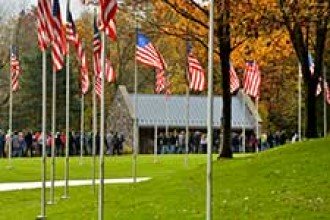
Students at Fort Custer
KALAMAZOO, Mich.--A brigade of more than 300 students from Western Michigan University's Haworth College of Business are enlisting in the college's second annual community service project at Fort Custer National Cemetery in Augusta, Michigan, where they will clean the headstones of nearly 2,000 graves in preparation for Veterans Day.
The students will clean headstones from 9:15 to 11 a.m. Saturday, Nov. 1, as a part of the business college's First Year Experience activities. The student battalion will represent 14 sections of the college's FYE course, with course instructors and faculty of the college leading students in the project. Veterans Day is Tuesday, Nov. 11.
"Fort Custer is a beautiful cemetery, and seeing all of the headstones is a very meaningful experience for the students and for us, knowing that each person served our country," says Paul Hildenbrand, FYE instructor and project co-coordinator. "Cleaning the headstones is a small but significant way for students to recognize the sacrifices these individuals made for their country and for students like them."
Service for those who served
The project kicks off with a history of the Fort Custer cemetery and the purpose it serves in the community. Students will proceed with cleaning headstones at 9:15 a.m.
"Flags are placed on each grave on Memorial Day, so we didn’t want to recreate that experience," says Tomika Griffin-Brown, FYE instructor and project co-coordinator. "The Fort Custer employees appreciate that we are willing to clean headstones as part of their Veterans Day observance."
Business students in the First Year Experience program have a history of helping the community with service projects in the past, such as helping with city beautification projects in downtown Kalamazoo. This project, though, is the second annual trip to Fort Custer. The business students in the program have collectively taken on a common project to be carried out annually to help the community.
"The letters and thank you notes we received from people all over the country last year after we visited Fort Custer were inspiring," says Hildenbrand. "This service project touched so many people last year, including our students."
The students certainly aren't the only ones who benefit from the involvement, though. The project coordinators chose to make this a yearly event, because of the incredible feedback received and the positive effect on students, instructors and the community.
"I think the instructors gain the same things that the students do," says Griffin-Brown. "Seeing how our students react to the service project is so fulfilling."
First Year Experience Programs, which encompass New Student Orientation, Fall Welcome, Transfer Student Services and the First-Year Seminar course, were introduced in 2005 to make the transition to college easier for incoming students and help them have a successful first year.
Fort Custer
Fort Custer was named after Gen. George Armstrong Custer, a native of Michigan. The original Camp Custer was built in 1917 on 130 parcels of land, mainly small farms leased to the government by the local Chamber of Commerce as part of the military mobilization for World War I.
The establishment of Fort Custer Post Cemetery took place on Sept. 18, 1943, with the first interment. As early as the 1960s, local politicians and veterans organizations advocated the establishment of a national cemetery at Fort Custer.
The Fort Custer site, located midway between Chicago and Detroit, was the Department of Veterans Affairs' choice for the Region V national cemetery. Congress created Fort Custer National Cemetery in September 1981. The first burial took place on June 1, 1982.
For more news, arts and events, visit wmich.edu/news.
